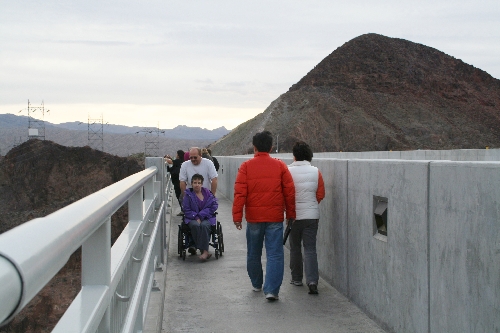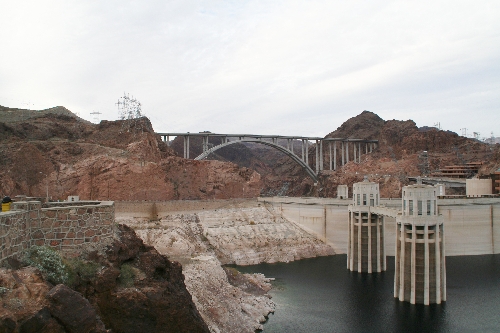Best dam views are accessible to all


The Mike O’Callaghan-Pat Tillman Memorial Bridge (Hoover Dam Bypass Bridge) on U.S. 93 offers a magnificent visual experience that is accessible to all, and there is no fee to access it. Opened on Oct. 19, 2010, the bridge spans the Black Canyon of the Colorado River approximately 1,500 feet south of Hoover Dam.
This bridge was the first concrete-steel composite arch bridge in the United States. It’s now the longest bridge of its sort in the western hemisphere, at 1,905 feet. It’s 88 feet wide. The walkway is 880 feet above the Colorado River, making it the second highest-walking bridge in the United States.
Pedestrian traffic is allowed along the bridge’s north side, but it is accessed only from the Nevada side. Although there are stairs from the parking area, there are also a series of paved, low-angle switchback ramps. From the parking area to the bridge walkway, those using wheelchairs, strollers or scooters will use these eight paved switchbacks. Although their grade is gentle, those in a wheelchair may need assistance to travel the full distance to the walkway, about 1,000 feet.
At the summit of the switchbacks, many resting benches are available before venturing onto the walkway itself, and interpretive signs give you something interesting to read while resting. Once on the walkway, it is approximately six feet across and about 900 feet to the center of the bridge. As you head across the bridge you will find numerous interpretive signs including one that marks the Arizona-Nevada state boundary.
Besides getting a spectacular view of the dam, you can also see a section of Lake Mead, the largest man-made lake in the United States, which the dam created. The white band along the lake’s perimeter, well above the waterline, is the former shoreline, showing how far the lake has dropped during the long recent years of drought.
Looking down at the lower section of the dam, you can see the location of the turbines that generate hydroelectrical power used throughout the Southwest. A local landmark, Fortification Hill, can be easily viewed from the walkway.
Once they have seen Hoover Dam from the walkway, many visitors also enjoy driving across the dam itself to view it from the Arizona side. From the Memorial Bridge Plaza parking area, head east to drive about two miles across the dam to where the road terminates. Along this drive there are parking and viewing areas for the bridge, dam and Lake Mead. One of the best views is on the Arizona side of the dam at Parking Area 12. Accessible parking is available at all parking areas.
Although accessible tours of the dam itself are not available, the Hoover Dam Visitor Center and Powerplant Tour are wheelchair- and scooter-accessible. For $5 at the main parking garage, wheelchairs can be rented to use on the Powerplant Tour or visiting other locations at the dam. Tours are not recommended for anyone who suffers from claustrophobia or who may have a pacemaker or defibrillator. Call 702-494-2517 or visit www.usbr.gov/lc/hooverdam.
Deborah Wall is the author of “Base Camp Las Vegas: Hiking the Southwestern States” and “Great Hikes, A Cerca Country Guide,” published by Stephens Press. Dennis Boulton is a retired Nevada schoolteacher and geologist. They can be reached at deborabus@aol.com.












